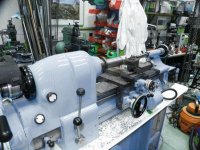I made a test bar to check alignment of the tailstock on the new to me 9" Logan Lathe. I have to really tighten the tailstock against the shaft to get a decent finish on the round stock close to the tailstock. The piece near the chuck looks good with very little pressure on the shaft. I have a live center in the tailstock.
How much pressure should I need to get a good finish? If I am using too much pressure, where do I look for the problem?
Do I need to say i am new to this?
Thanks
How much pressure should I need to get a good finish? If I am using too much pressure, where do I look for the problem?
Do I need to say i am new to this?
Thanks






